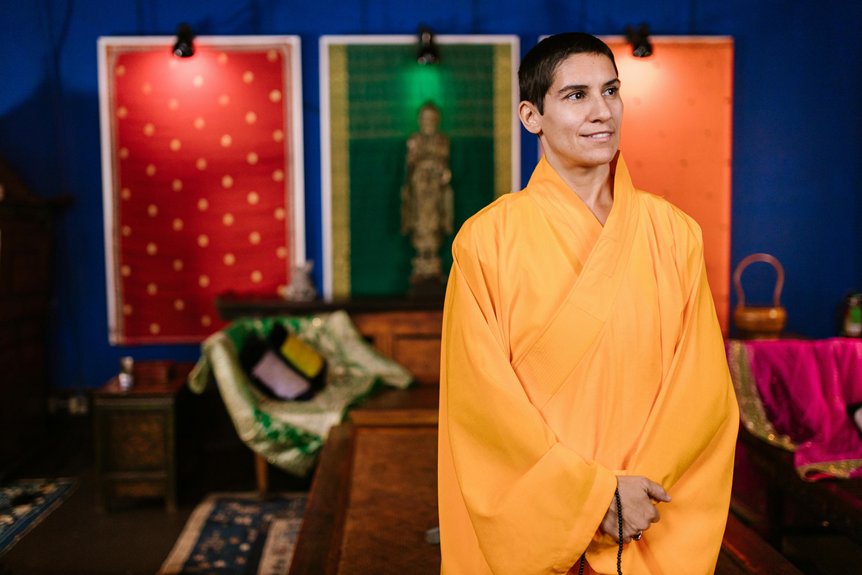Kykkos Monastery’s spiritual significance emerges from its miraculous Virgin Mary icon, purportedly painted by Apostle Luke, which embodies divine intervention. You’ll discover a sacred sanctuary where Byzantine architectural elements, intricate mosaics, and profound monastic traditions converge. The monastery transcends a mere religious site, representing a powerful spiritual conduit connecting celestial and earthly domains. Explore further, and you’ll uncover layers of Orthodox Christian mysticism waiting to be revealed.
Key Takeaways
- The monastery’s founding through Emperor Alexios I Komnenos’ celestial vision represents a profound moment of divine spiritual communication and intervention.
- The legendary icon of the Virgin Mary, reportedly painted by Apostle Luke, serves as a powerful spiritual artifact with miraculous protective properties.
- Byzantine architectural design, including intricate mosaics and frescoes, transforms the monastery into a profound visual theological medium for spiritual contemplation.
- Rigorous monastic practices of prayer, liturgical ceremonies, and spiritual discipline establish the monastery as a dynamic center of religious heritage and contemplation.
- The monastery’s pilgrimage traditions, centered around the miraculous icon, enable devotees to experience deep spiritual transformation and connection with centuries-old religious practices.
Tracing the Spiritual Origins of Kykkos Monastery
The spiritual genesis of Kykkos Monastery emerges from a profound Byzantine narrative of divine intervention and sacred revelation. When you explore this historic site nestled in the Troodos Mountains, you’ll discover a remarkable story of Emperor Alexios I Komnenos experiencing a celestial vision that guided him to establish this significant religious landmark. The monastery’s founding transcends mere architectural construction; it represents a pivotal moment of spiritual communication between the divine and human domains.
During a kykkos monastery troodos religious tour, you’ll learn how the monastery’s origins are intrinsically linked to miraculous encounters and Orthodox Christian traditions. The sacred icon of the Virgin Mary, traditionally attributed to the Apostle Luke, further amplifies the site’s spiritual significance. Its placement within the monastery symbolizes a profound connection between heavenly guidance and earthly manifestation, transforming Kykkos from a geographical location into a powerful spiritual sanctuary that has sustained Orthodox religious heritage for centuries.
The Miraculous Icon of the Virgin Mary
Stemming from the monastery’s profound spiritual origins, an extraordinary artifact epitomizes Kykkos’ religious significance: its miraculous icon of the Virgin Mary. This venerated image, purportedly painted by the Apostle Luke, transcends mere artistic representation, embodying divine intervention and spiritual potency.
| Miraculous Attribute | Spiritual Significance |
|---|---|
| Divine Origin | Apostolic Creation |
| Protective Power | Island Preservation |
| Mystical Visibility | Limited Exposure |
The icon’s profound mystique is amplified by its restricted visibility, with only the top half displayed during specialized prayers. Its reputation for miraculous protection extends beyond visual representation, substantiated by accompanying relics like a bronze arm and sawfish saw. These physical manifestations reinforce the icon’s spiritual narrative, transforming it from a mere religious artifact into a national treasure.
Pilgrims from diverse geographical backgrounds are drawn to this powerful symbol, seeking spiritual connection and experiencing the icon’s transcendent energy. Its enigmatic nature continues to inspire reverence and contemplation among believers.
Byzantine Architecture and Spiritual Design
While Byzantine architectural principles permeate Kykkos Monastery, its spiritual design transcends mere structural aesthetics, embodying a profound theological narrative through meticulously crafted spatial and visual elements. You’ll observe how the monastery’s domed basilica and intricate decorations serve as a sophisticated theological medium, transforming architectural components into spiritual communicative devices.
The iconostasis, strategically positioned as a sacred boundary, and the luminous interior illuminated through carefully placed windows, aren’t merely design choices but deliberate theological expressions. You’ll discover how natural light symbolizes divine presence, while mosaics and frescoes function as visual scriptural texts, guiding spiritual contemplation through meticulously rendered biblical narratives.
The architectural harmony-evident in courtyards, passageways, and spatial relationships-cultivates a holistic spiritual experience. Each architectural element becomes a carefully orchestrated metaphor, transforming the physical space into a transcendent theological landscape that invites profound spiritual reflection and connection.
Monastic Life and Spiritual Practices
Though centuries of monastic tradition have shaped its spiritual landscape, Kykkos Monastery represents a profound microcosm of Orthodox Christian contemplative life, where daily rhythms are meticulously structured around prayer, work, and spiritual discipline. You’ll discover a rigorous routine that demands unwavering devotion and commitment from its monastic residents.
The monastery’s spiritual practices center on regular liturgical ceremonies that transcend mere ritualistic performance. You’ll witness monks engaging in contemplative prayer, meditation, and religious observances that connect them deeply to their faith. The presence of the revered icon of the Virgin Mary, attributed to the Apostle Luke, amplifies the spiritual intensity of these practices.
Beyond ceremonial aspects, you’ll observe how the monastery functions as a dynamic spiritual and cultural institution. Its ecclesiastical museum and educational initiatives reflect a holistic approach to spiritual life, where preservation of religious heritage and active community engagement are intrinsically linked to monastic principles.
Pilgrimage and Sacred Traditions
At the heart of Kykkos Monastery’s spiritual significance lies a rich tapestry of pilgrimage traditions that have drawn the faithful for centuries. You’ll discover that the monastery’s miraculous icon of the Virgin Mary, purportedly painted by the Apostle Luke, serves as the primary catalyst for these sacred journeys.
Kykkos Monastery’s sacred icon, painted by the Apostle Luke, beckons pilgrims into centuries of spiritual transformation.
The pilgrimage experience encompasses multiple profound dimensions:
- Devotees seek divine intervention through the icon’s renowned miraculous properties, particularly its historical protection against locust infestations
- Pilgrims engage in deeply ritualistic practices, participating in daily liturgies and venerating sacred relics like the bronze arm and sawfish saw
- Spiritual seekers connect with centuries-old monastic traditions, experiencing a transformative engagement with Cyprus’s deeply rooted religious heritage
Your participation in these sacred traditions allows you to transcend mere observation, becoming an active participant in a spiritual narrative that has sustained religious practice for generations. The monastery’s pilgrimage experience represents more than a physical journey-it’s a profound spiritual transformation embedded in historical and cultural significance.
Religious Art and Iconography
A visual sanctuary of spiritual expression, Kykkos Monastery’s religious art and iconography represent a profound witness to Byzantine artistic tradition and Orthodox Christian theological narratives. You’ll discover an extraordinary collection of sacred artifacts that transcend mere aesthetic beauty, serving as intricate theological texts communicating divine messages through visual language.
The monastery’s iconostasis exemplifies this spiritual communication, featuring masterful religious carvings and paintings that strategically mediate between earthly and celestial domains. You’ll observe how each meticulously crafted icon and fresco narrates biblical scenes with remarkable theological precision, inviting contemplation and spiritual reflection.
The renowned Icon of the Virgin Mary, traditionally attributed to the Apostle Luke, stands as the centerpiece of this artistic-spiritual landscape. Its presence embodies not just artistic excellence but also represents a tangible connection to early Christian traditions, demonstrating how religious art functions as a profound medium of spiritual transmission and theological understanding.
Spiritual Significance in Cypriot Orthodox Heritage
Deeply rooted in the spiritual landscape of Cyprus, Kykkos Monastery emerges as a profound embodiment of Orthodox Christian heritage, transcending its architectural boundaries to represent a living chronicle, record, or witness to centuries of religious devotion and cultural identity. Its spiritual significance extends far beyond mere architectural presence, serving as a dynamic conduit of theological transmission and preservation of Orthodox traditions.
A sacred testament to spiritual heritage, Kykkos Monastery illuminates centuries of Orthodox devotion and cultural memory.
The monastery’s spiritual resonance is characterized by:
- Its role as a transformative spiritual center that has nurtured numerous religious leaders, including Archbishop Makarios III
- The veneration of the miraculous icon of the Virgin Mary, believed to be painted by the Apostle Luke, which symbolizes deep theological connections
- A continuous monastic tradition that maintains unbroken spiritual practices dating back to the 11th century
Through its unwavering commitment to spiritual cultivation, educational initiatives, and philanthropic endeavors, Kykkos Monastery remains a critical nexus of Orthodox Christian spirituality in Cyprus, embodying centuries of religious devotion and cultural memory.
Preserving Spiritual Legacy Through Centuries
Since its founding in the 11th century, Kykkos Monastery has embodied a remarkable trajectory of spiritual preservation, skillfully maneuvering historical challenges to uphold its profound Orthodox Christian legacy. The monastery’s commitment to conservation transcends mere architectural maintenance, representing a holistic approach to preserving spiritual patrimony through meticulous artifact protection and cultural transmission.
The monastery’s strategic efforts involve safeguarding its most treasured possession-an icon allegedly painted by the Apostle Luke-while simultaneously maintaining its active monastic community. By integrating educational and philanthropic initiatives, Kykkos guarantees that its spiritual significance remains dynamically relevant rather than becoming a static historical relic.
Conservation strategies focus on preserving Byzantine mosaics, frescoes, and iconographic elements that communicate centuries of Orthodox spiritual tradition. These methodical preservation techniques not only protect physical artifacts but also sustain the monastery’s intellectual and spiritual continuity, allowing future generations to comprehend and experience its profound cultural significance.
Divine Miracles and Spiritual Encounters
Bridging the monastery’s historical preservation with its spiritual mystique, Kykkos Monastery emerges as a nexus of divine intervention and miraculous encounters. The monastery’s Virgin Mary icon, attributed to the Apostle Luke, transcends mere artistic representation, embodying a profound spiritual conduit of miraculous manifestations. Its revered status stems from extraordinary interventions that have shaped the island’s collective narrative.
Significant spiritual phenomena include:
- The icon’s supernatural protection against locust infestations, demonstrating divine ecological guardianship
- Miraculous maritime interventions, preserving sailors from treacherous sea storms through supernatural intercession
- Ritualistic spiritual practices that maintain the icon’s mystical aura, including partial visual concealment during prayers
The bronze artifacts accompanying the icon-a symbolic arm and sawfish saw-further authenticate the monastery’s supernatural legacy. Pilgrims are drawn to this sacred space, seeking transformative spiritual encounters that challenge empirical understanding and affirm transcendent divine interactions.
Frequently Asked Questions
Is KYKKOS Monastery Worth Visiting?
You’ll find Kykkos Monastery an intellectually compelling destination, transcending mere tourist attraction. Its architectural and historical significance offers profound insights into Byzantine religious traditions. You’ll encounter a meticulously preserved sacred space that epitomizes Cyprus’s spiritual heritage, featuring an allegedly Apostle Luke-painted icon and remarkable ecclesiastical artifacts. The monastery’s strategic mountain location and scholarly preservation make it an indispensable cultural experience for discerning travelers.
What Do You Wear to Kykkos Monastery?
Like a reverent pilgrim preparing for sacred rites, you’ll want to dress conservatively at Kykkos Monastery. Opt for clothing that covers shoulders and knees, resembling an academic’s professional attire. Women should bring a head covering for church entry, and prepare to remove shoes before sacred spaces. Choose comfortable, modest garments that respect the monastery’s spiritual ambiance, avoiding revealing or casual clothing that might disrupt the contemplative environment.
KYKKOS Monastery Is Located at an Elevation of Approximately 1,150 Meters (3,773 Feet) Above Sea Level
You’ll find the Kykkos Monastery perched at a significant elevation of 1,150 meters, strategically situated within the Troodos Mountains. This high-altitude location not only provides a remarkable geographical positioning but also contributes to the monastery’s environmental distinctiveness. The elevated terrain offers cooler temperatures and expansive panoramic views, creating a serene and contemplative spatial context that enhances the monastic experience.
When Was Kykkos Monastery Built?
You’ll be intrigued to learn that Kykkos Monastery was established around 1089, during the late Byzantine period under Emperor Alexios I Komnenos. Though the original structure has been destroyed and rebuilt multiple times, the monastery’s foundational date remains consistently traced to the late 11th century. Its architectural evolution reflects centuries of reconstruction, with the current buildings representing various historical periods of Cyprus’s rich ecclesiastical heritage.
Conclusion
Kykkos Monastery stands as a luminous beacon of spiritual transcendence, where divine symbolism and Orthodox traditions intertwine like sacred threads. You’ll discover that its profound significance lies not just in architectural magnificence, but in its ability to preserve celestial connections between earthly devotion and heavenly grace. This monastery isn’t merely a structure, but a spiritual vessel carrying centuries of Cypriot religious heritage.

Meet Natalie, who has lived on Cyprus for the last 10 years. She loves exploring the beautiful nature of the island, like quiet forests and untouched beaches. Natalie has lots of cool experiences to share. Join her as she talks about her adventures in Cyprus.

